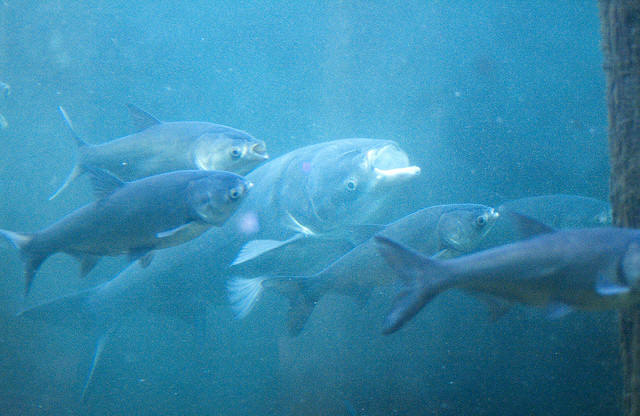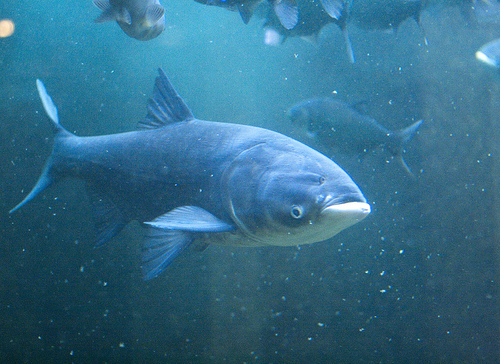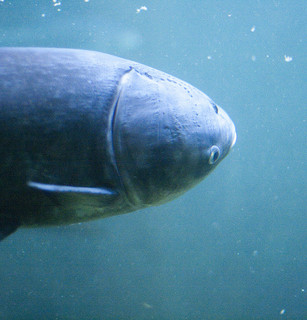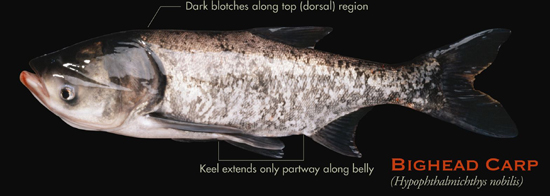Adaptation
To some the Bighead carp might not be considered the best looking in the world, but there is no doubt that they have some unique adaptations to them.
The first noticeable observation made when looking at these fish is
the unique head structure; specifically the jaw region. Bighead
carp have a distinguishable lower jaw, that rises and protrudes outward.
Besides an upturned jaw, the eyes of a Bighead are much lower and more
forward set when compared to the rest of the body. The mouth of a
Bighead carp is considered toothless and they lack barbels that are found on other
fish. Barbels are just the fleshy "whiskers" found on fish, which
are receptors used for feeling and tasting around the environment.
There is a presence of pharyngeal teeth that are located on the gill
arches used for grinding prey. The common name
gives clues to the body to head ratio, where their heads are often
longer and larger in size, thus the name "Bighead". Another
adaptation of the head region is the lack of scales.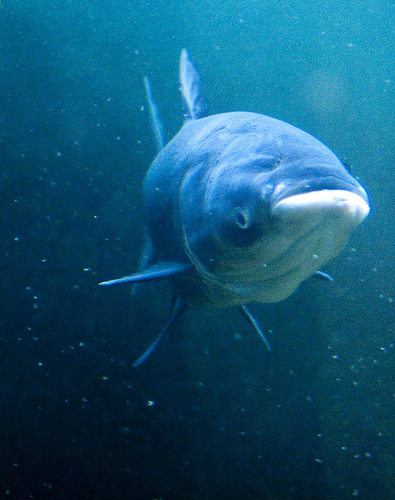
More then What Meets the Eye: As we continue on to
the rest of the body you will notice distinguishable dark blotches all
across the fish. These blotches are especially found to be focused
around the dorsal region of the fish. For a better idea of where
the dorsal region is and what these blotches look like view the
elongated image above. The typical color of the rest of the body
is usually a grey color with a whiter underbelly. Following along
the top of the body you will find the dorsal fin. This dorsal fin
consists of the dorsal spine and rays. The rays are flexible and
segmented in the dorsal fin. The main purpose of the dorsal fin
for Bighead carp and many other fish is to provide stability. This
fin also aids in sharp movements through the water, as well as prevents
the fish from rolling. Besides the dorsal fin you can find the
ventral and anal fins along the bottom of the fish. The Bighead
has a distinguishable keel as well. The keel is the smooth
abdominal edge starting from the ventral fin, extending beyond the
pelvic base to the anal fin.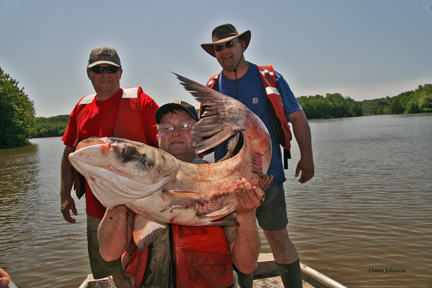 These fish also have a unique gill structure when compared to other
organisms with gills such as the Smallmouth Bass, a common game fish of
North America. Click
here to compare adaptations of the Smallmouth with the Bighead carp!
The gill rakes are very long, thin, and dense in numbers helping
increase the flow of fresh water across the gills to increase in
respiration. Since the gills rakes are large it promotes gas
exchange so Bighead carp can survive better in less oxygenated water.
The actual process of gas exchange is fairly simple in these organisms.
The circulatory system of Bighead carp is classified as an enclosed
circulatory system. As deoxygenated blood coming from the body is
pumped into the atrium of the heart and then out the ventricle heading
towards the gills where the blood can obtain oxygen.
These fish also have a unique gill structure when compared to other
organisms with gills such as the Smallmouth Bass, a common game fish of
North America. Click
here to compare adaptations of the Smallmouth with the Bighead carp!
The gill rakes are very long, thin, and dense in numbers helping
increase the flow of fresh water across the gills to increase in
respiration. Since the gills rakes are large it promotes gas
exchange so Bighead carp can survive better in less oxygenated water.
The actual process of gas exchange is fairly simple in these organisms.
The circulatory system of Bighead carp is classified as an enclosed
circulatory system. As deoxygenated blood coming from the body is
pumped into the atrium of the heart and then out the ventricle heading
towards the gills where the blood can obtain oxygen.
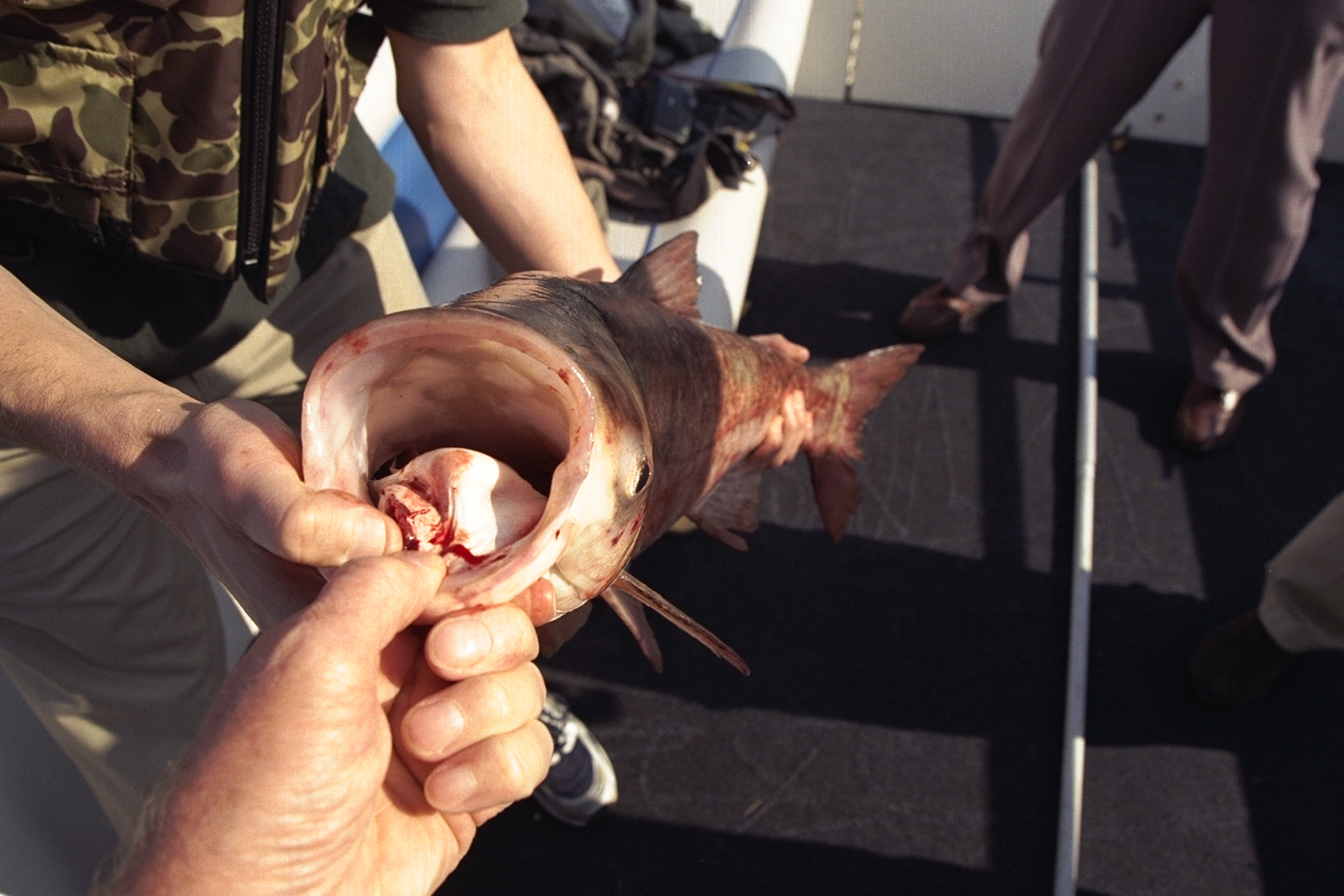 Thanks to the
gill structure it increases the surface area and blood can pump through
the tiny capillaries housed in the gills where oxygen is exchanged
through the tiny walls into the blood vessels thanks to the process of
diffusion. The blood then continues to the rest of the body where
oxygen is needed for cellular respiration. The blood diffuses
oxygen across the low concentrations thanks to capillaries to different
areas of the body. Then blood will make the trip back to the heart
to continue the process all over again.
Thanks to the
gill structure it increases the surface area and blood can pump through
the tiny capillaries housed in the gills where oxygen is exchanged
through the tiny walls into the blood vessels thanks to the process of
diffusion. The blood then continues to the rest of the body where
oxygen is needed for cellular respiration. The blood diffuses
oxygen across the low concentrations thanks to capillaries to different
areas of the body. Then blood will make the trip back to the heart
to continue the process all over again.
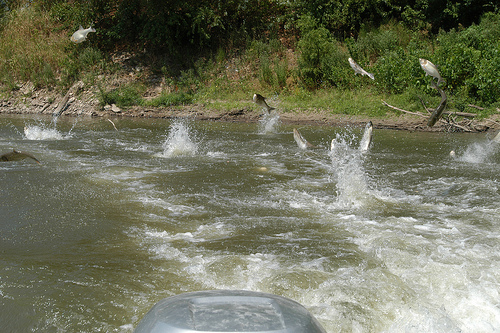 One of the most important adaptations to Bighead carp is the fact
that these fish can grow to large sizes so quickly. This
adaptation allows Bighead carp to overrun many of the native fish as
they eat the main food supply. Their large size and quick growth
allows them to compete with the native fish, forcing the native fish out
of their environment. This competition in the same niche causes a
stress on many organisms, decreasing populations of the other organisms
as the Bighead carp decimate the food supply and continue to grow and
reproduce at fast rates. Bighead carp can actually reach sizes of
100 pounds, but often average between 40-50 pounds.
One of the most important adaptations to Bighead carp is the fact
that these fish can grow to large sizes so quickly. This
adaptation allows Bighead carp to overrun many of the native fish as
they eat the main food supply. Their large size and quick growth
allows them to compete with the native fish, forcing the native fish out
of their environment. This competition in the same niche causes a
stress on many organisms, decreasing populations of the other organisms
as the Bighead carp decimate the food supply and continue to grow and
reproduce at fast rates. Bighead carp can actually reach sizes of
100 pounds, but often average between 40-50 pounds.
Interested in how much Bighead carp can eat? Click here to find what makes a meal for them!
